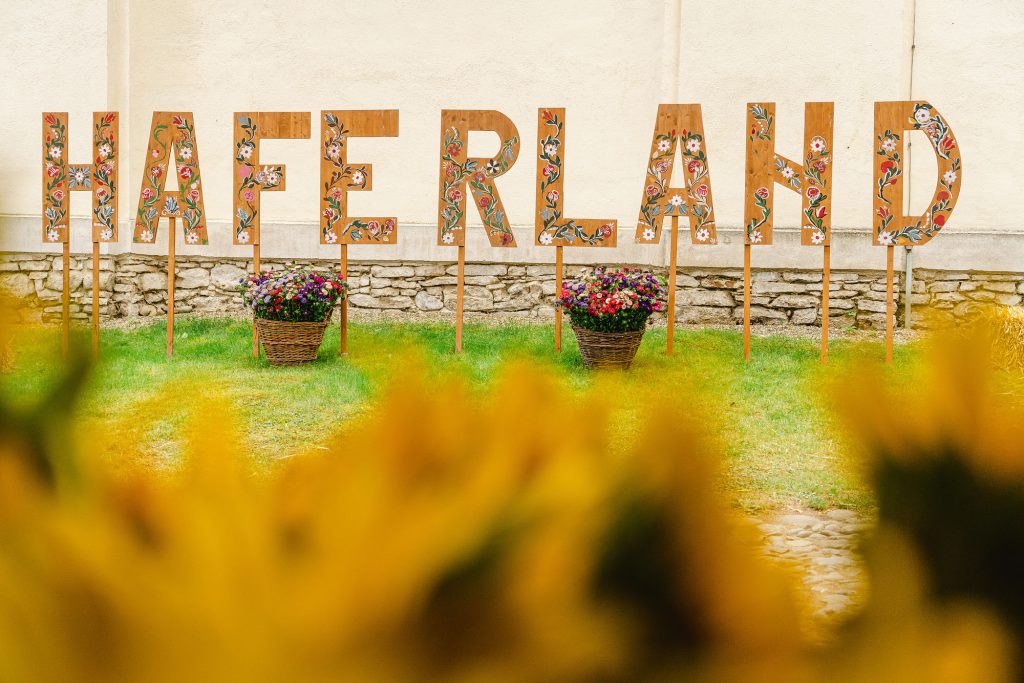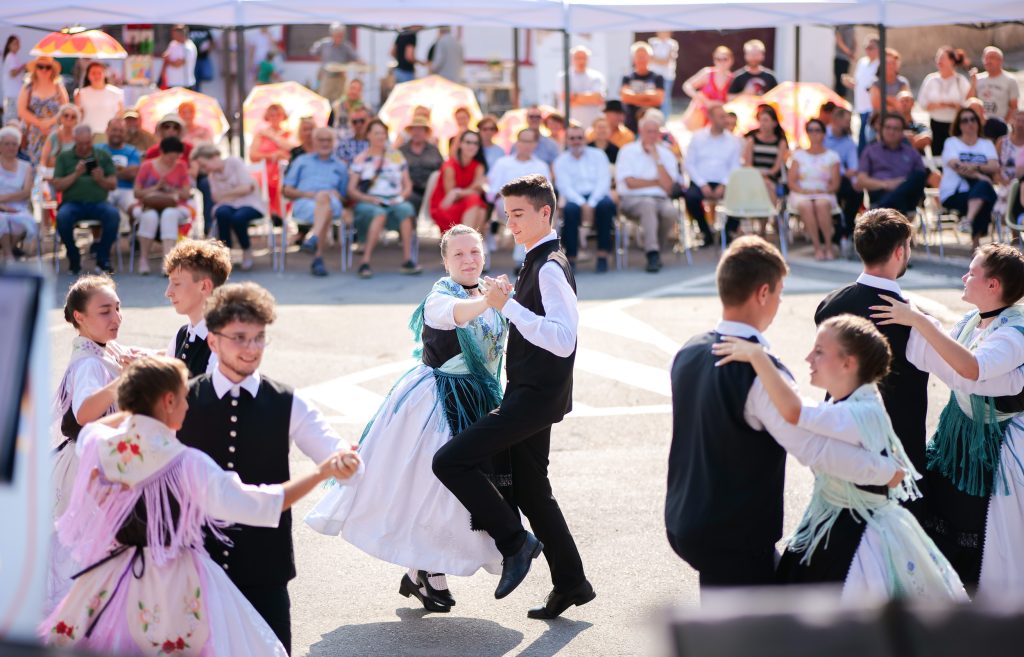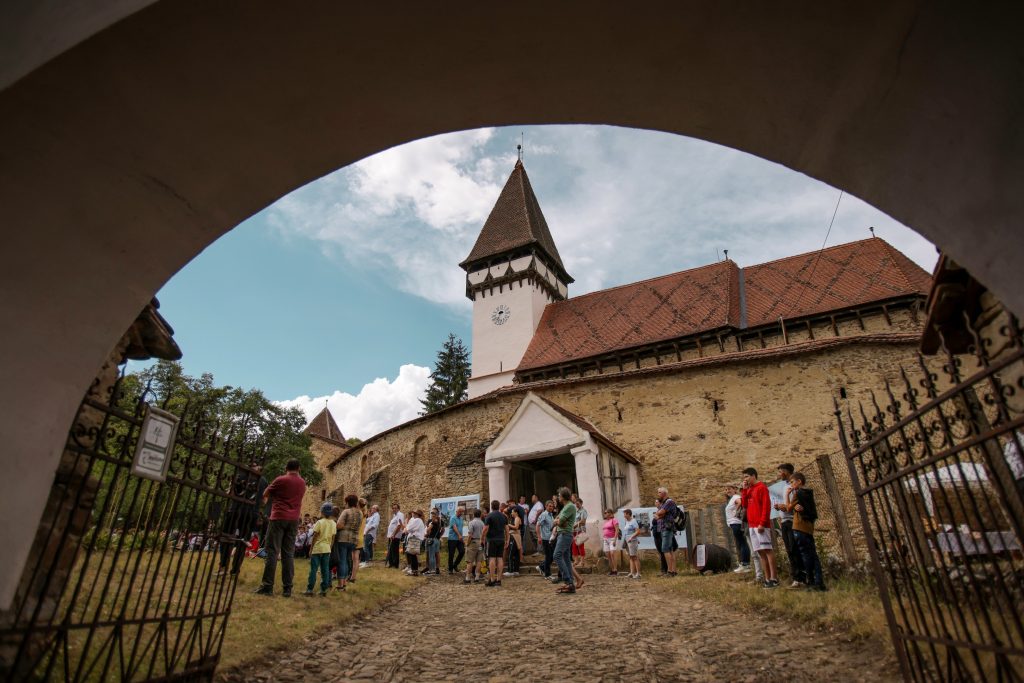:quality(80)/business-review.eu/wp-content/uploads/2023/07/Screenshot-2023-07-24-at-1.05.15-PM.png)
Haferland Week, a celebration of Transylvanian Saxon culture, beckons us to explore the allure of local tradition, this year with a special emphasis on sustainability. Join Business Review as we venture behind the scenes to unveil the essence of this remarkable event – with Michael Schmidt, M&V Schmidt Foundation president, and the main organizer of the event.
The 11th edition of Haferland Week, the largest festival dedicated to the culture and traditions of Transylvanian Saxons, will take place from August 3-6 across ten villages, in the region historically known as the “Land of Oats:” Archita, Saschiz, Homorod, Rupea, Criț, Roadeș, Meșendorf, Cloașterf, Bunești, and Viscri.
This year, visitors will be able to enjoy Saxon music and organ concerts, traditional craft workshops for children and adults, traditional Saxon balls, visits to farms and traditional local homes, organic product tastings, and much more.
How was the Haferland Week festival received by the Transylvanian Saxon communities in Romania, and what was the impact on their engagement and support?
The Saxon communities in Transylvania are the main stakeholder and an active participant in our event. The festival was originally created as an opportunity for the people of Haferland to highlight their way of life – their cultural and material heritage. We just provided some structured framework for all that richness of life experiences to find its way to an outside audience.
With some exceptions like the guest conferences, most of the festival’s events are either entirely created or curated by locals, so they’re more or less running the show, so to speak; theirs is the stage.
Now, about the “engagement” part of your question: since 2017, the festival has been taking place in the same ten villages every year, but the number and diversity of events have been steadily growing, involving an increasingly larger share of the local population. Each year, several hundred people in the local communities are involved in the organization of our event; for many of them, this is an opportunity to showcase their home, craft or business. Occasionally, the festival even hosts major community events like this year’s re-consecration of the Evangelical Church in Rupea. Over the years, the festival has become an integral part in the life of the Saxon communities.
On the other hand, the fact that the Haferland name has stuck speaks for itself. 15 years ago very few people knew what it meant. Today, the name unequivocally identifies the Saxon villages lying along the road between Brasov and Sighisoara. That is part of the festival’s legacy. We’ve literally put Haferland on the map.
Over the course of 11 years, the M&V Schmidt Foundation has accumulated valuable expertise in promoting Transylvanian Saxon communities. If you were to create the concept of Haferland Week now, in 2023, what innovative approaches would you employ to maximize its success and outreach?
Haferland Week is not a static concept. With every year it continues to develop and incorporate more diverse events and experiences so everything is still on the table in terms of promotional strategies. On the other hand, the events that make up the festival showcase the life of a community that is trying to preserve its identity while the world around is changing rapidly, so conservation, generally speaking, is a strong priority. The festival has to look both to the past and to the future. I would add that Haferland Week has come to be defined rather by its small footprint and its tradition-oriented program, so any changes would have to build on that.
The first half of the equation, the side facing the past, is the simplest part to deal with. I’m clearly aware that the thriving Saxon community I grew up in is gone forever; there are too few Saxons of my generation left.
But my ancestors’ way of life, their traditions, songs, food, their houses and their churches, these can definitely be saved from oblivion. It’s a matter of making sure the Saxons have a place here they can call home, even as this place now welcomes young affluent ethnic Romanians and foreigners who are drawn here by the magic of these places. Many of these young people love these places precisely for what they mean, for their history and cultural heritage.
Which is what gets us to second part of the question: what kind of future do we envision, and how do we make sure it is within our reach? Maybe in the following years we’ll do a tie-in with one of the major summer cultural or music festivals in Transylvania by hosting some of their shows, or develop a digital version of Haferland for people to experience at home, or maybe start a side touristic project in the area. As I said, all options are on the table.


With this year’s theme centered around sustainability, how do you personally embrace the concept of sustainability? How does MHS Holding align itself with sustainability principles, and what initiatives have been undertaken to drive sustainable practices within the organization? Additionally, as the president of a foundation, how do you prioritize sustainability in the projects you undertake?
As someone who’s worked in the automotive industry for most their professional life, I follow closely the global trend toward electric transportation. It is now clear that we are headed for a future where fossil fuels are being replaced with cleaner energy sources, at least in the transportation sector. It’s not only the increasingly stringent emissions regulations put forth by the EU; the market is also going that way by itself. By 2024, about a third of BMW’s entire output will be electric cars. So I have a personal interest in seeing that MHS’s businesses go where the market is – that is, towards a future that is more respectful with our planet, our air, our environment, and our children’s future.
Hence, we are also prioritizing going electric not just in terms of business. We are currently focusing on rethinking our sales portfolio to give a larger share to electric vehicles, and we support other organizations reach their sustainability goals. For instance, we’ve provided Gheorghe Hagi’s Football Academy with a fleet of BMW i3 electric cars to help them reach their net zero objective.
The same goes for Haferland Week. I see it as one more way to make possible a sustainable future for the places where I grew up, for the children and grandchildren of my generation. So it’s no longer a matter of preference. Rather, it’s something that absolutely needs to be done if we want to have a better future.
I’m lucky to be working in an industry that is decarbonizing faster than almost any other sector. Yes, I admit I’m a bit nostalgic about the high-powered, petrol-hungry cars my younger self loved so much, but there’s something very satisfying in knowing we’re doing something good for the future of the planet. And besides, the new electric BMW are anything but boring. The all-electric i7 M70 xDrive in particular is truly mind blowing.
As to the projects our foundation supports, sustainability is already factored in, so to speak. By default, we fund projects that have a lasting impact on the community. Education, in particular, is one of the most cost-effective ways to support the development of a community. For Haferland Week, we prioritize those projects that highlight strong traditions of Saxon life in Transylvania, things that other people can relate to, understand, and ultimately appreciate and preserve.
During the press conference, you emphasized that these historic Transylvanian Saxon communities have a sustainable future in Transylvania. In this context, how do you define a sustainable future, and what specific measures are being taken to ensure the long-term viability and prosperity of these communities?
By sustainable future, I mean one where the local way of life is more or less preserved indefinitely, along with everything that makes it possible – the language, the local customs, the structures that hold the community together, like the local church, and so on.
Sure, things will not be exactly as they were when I was little. That time is gone. I hope that the next generation of locals will be, if not Saxons or German-born, at least respectful of our great heritage. Maybe the young people who move here with their families will learn some of the local dialect and a few Saxons will continue to live here. Maybe the descendants of those who emigrated left for Germany will keep on returning every summer, as they are doing now. I believe that in some form, the cultural melting pot that Haferland has always been will live on.
Fortunately, such projects are thriving across Europe, thanks partly to a marketing trend towards promoting the local and authenticity of experiences, and partly to a genuine desire of people to reconnect to their past.
To sum it up: in my view, in this context sustainability means the preservation of lived experience. Preserving the architectural heritage – the churches, the houses – is essential. It’s the backbone of the community. Also, that means avoiding industrial agriculture, the preservation of local growing practices, non-destructive practices in tourism and so on. The UNESCO Heritage status awarded to two Haferland villages (Viscri and Saschiz) is a strong defense against such intrusive practices but things should not be taken for granted. In my view, the entire area should enjoy some form of legal protected status.
As to the specific measures taken to preserve the area, there is much room for improvement. The UNESCO designation is great but only covers two villages, and mostly because of the historical value of their fortified churches. Some private historical homes are also protected but so far I don’t see much of a public strategy to preserve or help revitalize these villages. Charities like Mihai Eminescu Trust or H.M. Charles II have stepped in to do that work. But no NGO’s project can have the kind of systemic impact that is needed.

Given your extensive international connections, how would you articulate the essence of a traditional Transylvanian Saxon village to someone unfamiliar with its history and cultural significance? Similarly, how would you describe the unique characteristics and charm of a typical Romanian village?
I’ve said it more than once in the past: the Haferland villages are the living memory of a local civilisation that has thrived here for almost 8 centuries, one of the three major ethnic components that define Transylvania. They represent the essence of Saxon civilisation, with their unique mix of local architecture, crafts, food, and customs. Visitors can see and experience here a way of life that has its roots in Medieval Europe, a sort of Central European transplant into the farthest reaches of the East. Haferland is a gateway to experiencing Transylvania and its better known sights like the Black Church in Brasov, the city of Sibiu. Uniquely, and most importantly, Haferland gives visitors the opportunity to meet a living Saxon community that has been there since the times of the Crusades.
As to Romanian villages in general, my experience is rather limited to those in Transylvania (as opposed to rural areas in Moldova or the deep South, where I haven’t been much). I would say that Transylvanian villages have an unique mix of natural sights, spoken languages, ethnicities, cultures, and traditions that you won’t find anywhere else in Central Europe.
From the perspective of the foundation you lead, what are the key elements currently lacking in the development of Transylvanian villages? How can the foundation address these gaps and foster sustainable growth? Moreover, what aspects would local tourists and international visitors desire to see enhanced in the Transylvanian village experience?
In my view, what is needed is sustainable, smart development. By that, I mean funding for restoration projects, for preserving the local natural environment, for ensuring that development does not alter the specificity of communities. Otherwise, the risk of gentrification and over-commercialization is real.
Haferland should be considered as a whole because it was, and still is, a unique community, slightly different than other German-speaking communities in Transylvania. One way to do that might be by establishing some guidelines for regional development in culturally sensitive areas. We would thus be able to ensure that funds are used to restore culturally important buildings, or that we don’t end up with major touristic developments in the middle of what is, and should remain, a small rural community. The area, as it is now, is fragile and needs protection.
In your role, you have successfully applied corporate practices from your businesses to the foundation. Can you highlight specific strategies or principles that have been adopted from your corporate experience and integrated into the foundation’s operations? Likewise, what lessons have you learned from leading the foundation that you have implemented in your corporate endeavors?
Contrary to belief, business practices do not translate easily into charity work. But yes, some basic principles do apply crosswise. For instance, we tend to focus on high-efficiency, best value for money projects, like education, which has perhaps the best return on investment. Through Haferland Week, we aim to attract smart investments from outside investors who appreciate the cultural value of the area and can translate that value into financial gain while preserving the place for future generations.
Conversely, I believe that our charity work has taught me that having sustainability targets can actually be good for the business. It’s a way to stay attuned to the needs and values of the next generation of buyers, who are much, much more sensitive to issues like climate change and the value of cultural heritage.

In many of your business interviews, you emphasize the importance of investments. While the foundation’s work may not be measured solely by concrete financial metrics, it undoubtedly creates impact through meaningful projects. How does the foundation assess and measure the impact of its activities? What evaluation methods and indicators are used to gauge the effectiveness and success of the foundation’s initiatives?
When evaluating charity projects, two types of measurements come into play: the first is to assess whether the project has met its stated goals, like audience reach, engagement, number of beneficiaries, trends in the number of visitors to Haferland Week, and so on. Measuring impact, on the other hand, is much more difficult and expensive, if it is even possible at all.
As we are not a big organization, we do not operate with large budgets, so we tend to stick to what it’s proven to work: educational projects, cultural events, and so on.



:quality(80)/business-review.eu/wp-content/uploads/2024/07/VGP-Park-Timisoara_-8thbuilding_iulie-24.jpg)



:quality(80)/business-review.eu/wp-content/uploads/2024/06/22C0420_006.jpg)

:quality(80)/business-review.eu/wp-content/uploads/2024/06/COVER-1-4.jpg)



:quality(50)/business-review.eu/wp-content/uploads/2023/08/Biertan-cGAL-Dealurile-Tarnavelor-Sorin-Onisor.jpg)
:quality(50)/business-review.eu/wp-content/uploads/2023/07/Caroline-Fernolend-Presedinte-Fundatia-Mihai-Eminescu-Trust-scaled.jpg)
:quality(50)/business-review.eu/wp-content/uploads/2023/07/Crit-30-Iul-2022-201.jpg)
:quality(80)/business-review.eu/wp-content/uploads/2024/06/br-june-2.jpg)
:quality(50)/business-review.eu/wp-content/uploads/2024/07/America-House-Offices-Bucharest-Fortim-Trusted-Advisors.jpg)
:quality(50)/business-review.eu/wp-content/uploads/2024/07/BeFunky-collage-33-scaled.jpg)
:quality(50)/business-review.eu/wp-content/uploads/2024/07/BeFunky-collage-32-scaled.jpg)